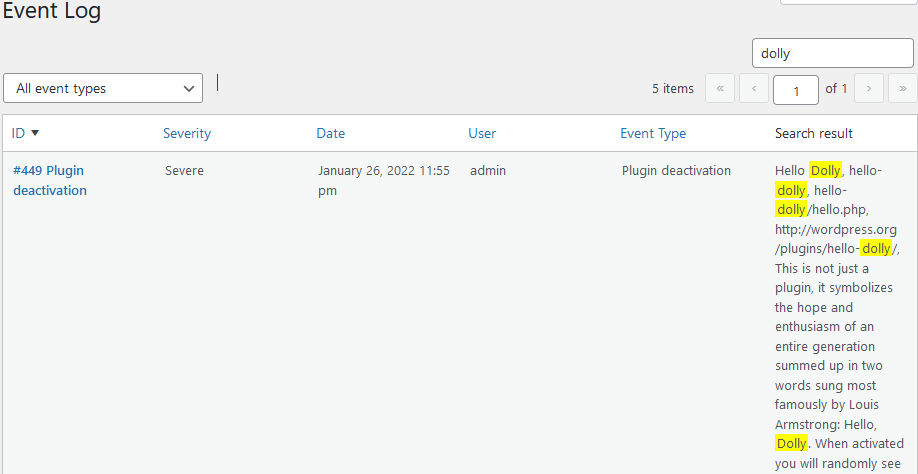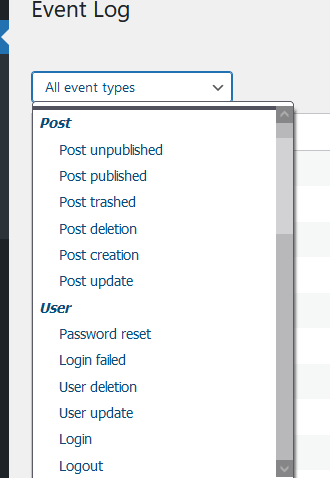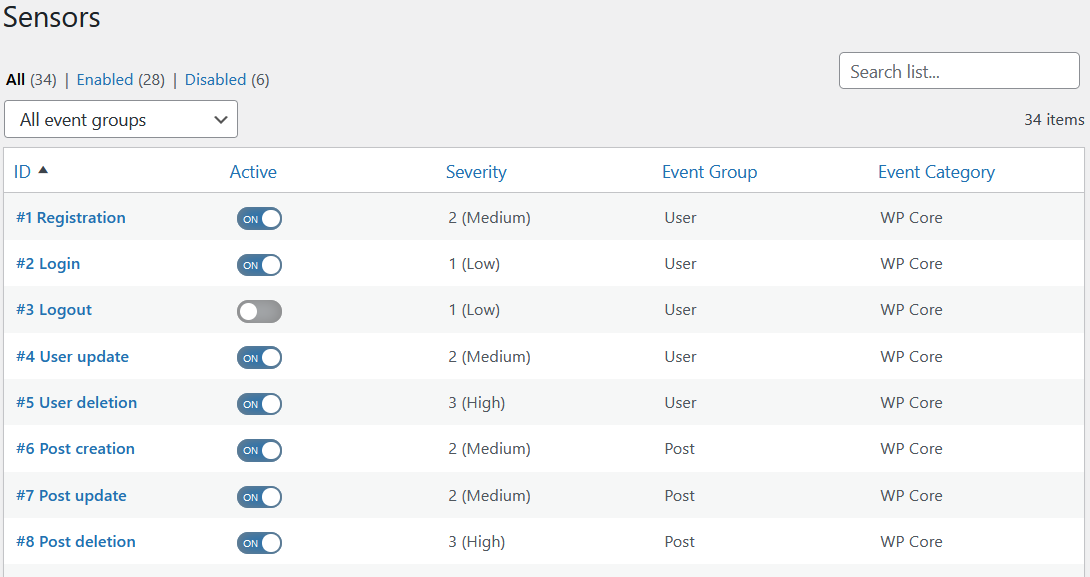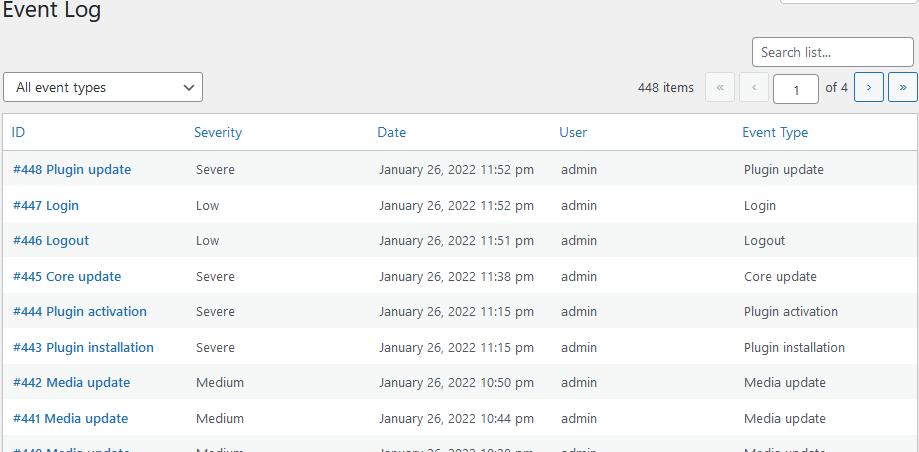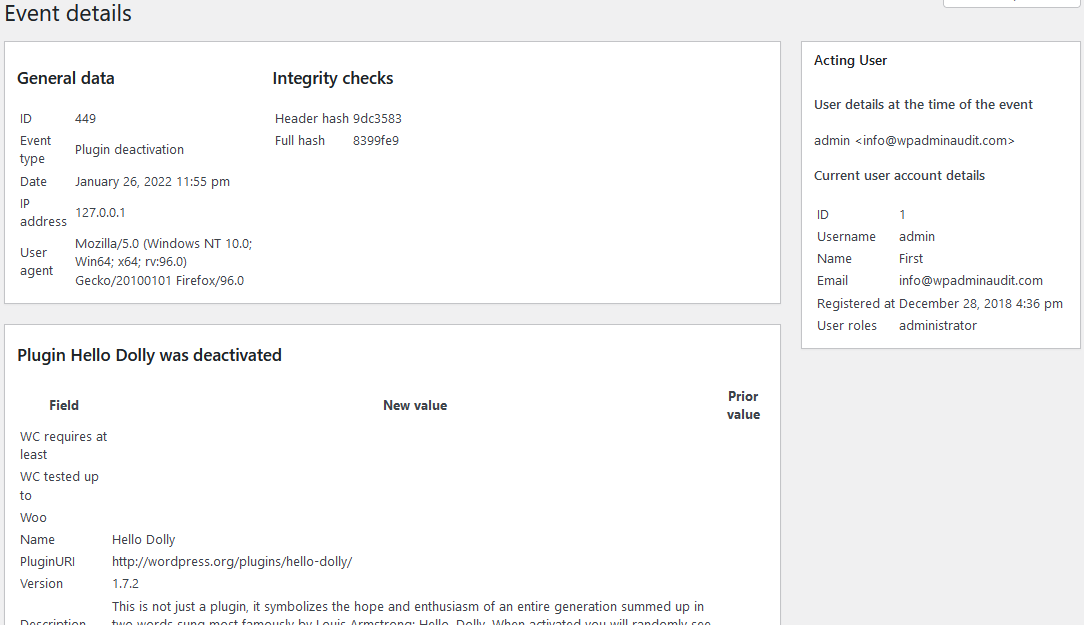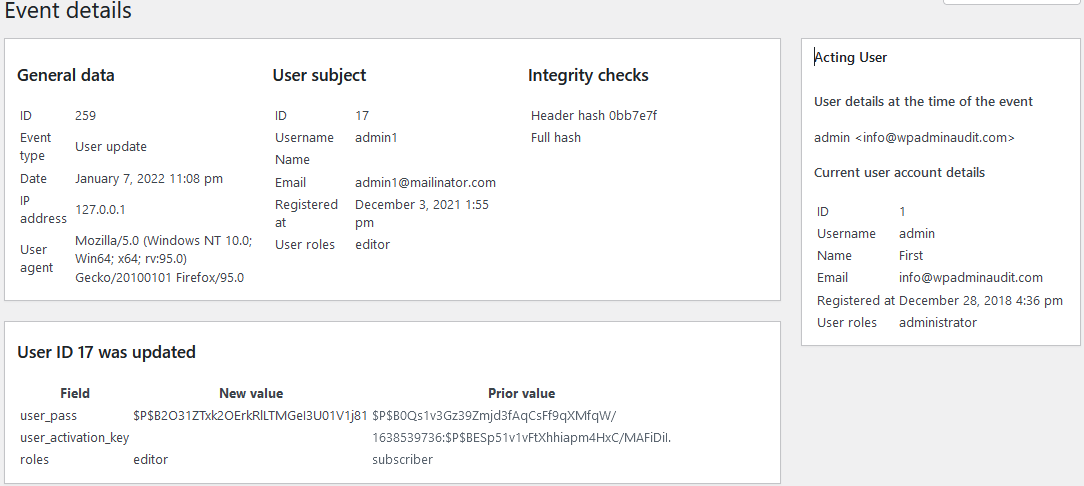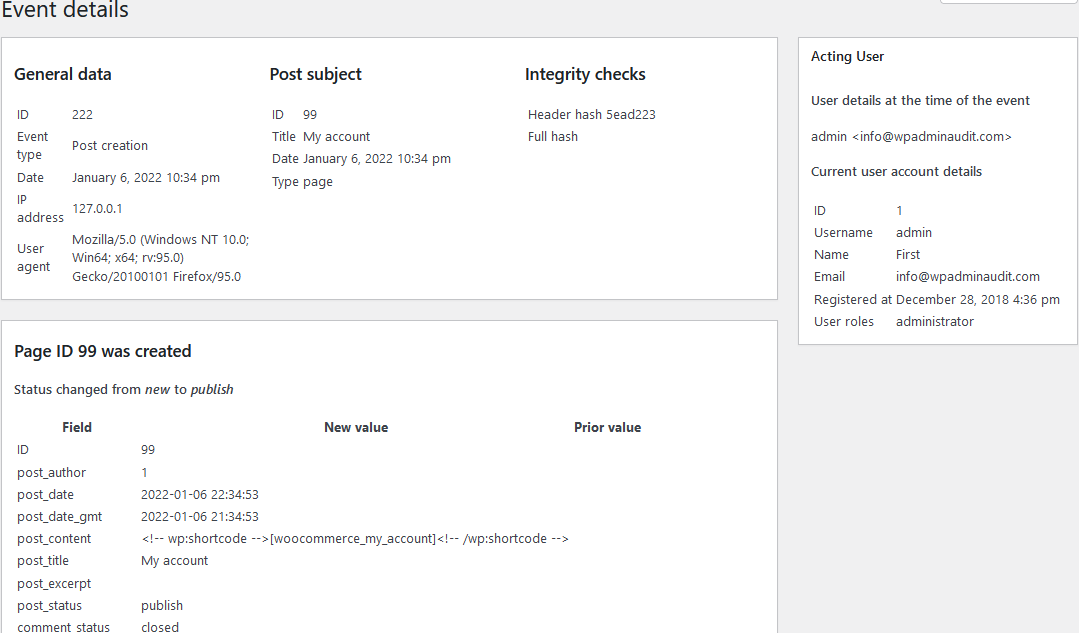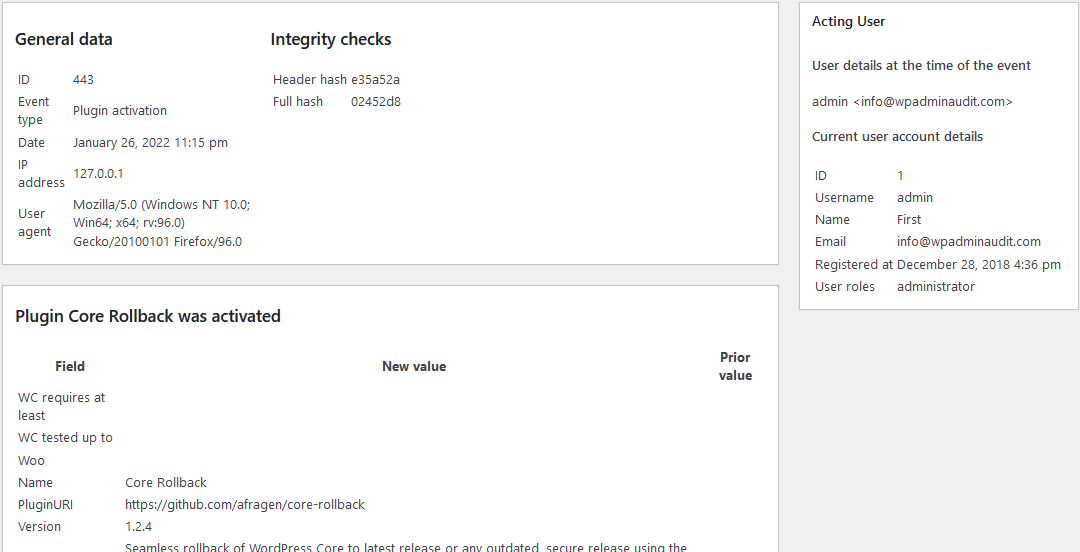WP Admin Audit
| 开发者 | brandtoss |
|---|---|
| 更新时间 | 2025年7月24日 05:45 |
| WordPress版本: | 6.8 |
| 版权: | GPLv2 |
| 版权网址: | 版权信息 |
详情介绍:
- who unpublished a post?
- when a plugin was deactivated?
- how that strange new admin account appeared?
- Have a log of every change that’s made
- Know about security-relevant activities
- Find out who did what and when they did it
- Analyze the steps that led to a technical problem
- Identify and mitigate automated login attempts by bots
- Content: Page and Post changes (e.g. post created/updated/published/unpublished/deleted)
- Taxonomy: Changes to Categories and Tags (e.g. tag is created, updated, or deleted)
- User: User registration, user profile updates, password resets, user deletions, login, and logout
- WordPress: Updates of the WordPress core version, settings updates (general/writing/reading/discussion/media/permalink/privacy settings)
- Plugin: Installation, activation, updates, deactivation, and deletion of plugins
- Theme: Installation, activation (theme switch), update, and deletion of themes
- Media: Media file and data creations, updates, and deletions
- Menu: Creation, updates, and deletions of menus
- Comment: Comment creations, updates, deletions, and status changes (approved, unapproved, spammed, etc.)
- File: File changes via the plugin file editor and theme file editor
- Event type
- Date and time
- IP address (the action/event originated from)
- Acting user (the user who did the change)
- Subject (the item affected e.g. a post the action is done with/to)
安装:
屏幕截图:
常见问题:
Where is the documentation?
Please see the documentation on our site.
How do I get support?
Feel free to reach out directly via the contact form.
Will you add event x?
Most probably yes! We know there are still some WP core events missing. This applies even more to 3rd party plugins where we want to release more extensions. The good news is that we very actively developing the plugin and look for the feedback of the users to know which events first to add. You can share your feedback directly within the plugin, there is a link in the Settings » Sensor menu item.
Can the plugin track the pages my visitors are browsing?
No, and we do not have any intention to add that kind of functionality. WP Admin Audit focuses on actions done by administrators and actions done by users which could be security relevant (e.g. user account creation, user role changes, ...).
Is WP Admin Audit translation ready?
Yes, WP Admin Audit has full translation and localization support via the "wp-admin-audit" text domain. Based on your site language, required .mo and .po translation files will be downloaded and placed into the default WordPress languages directory.
How can I report security bugs?
You can report security bugs through the Patchstack Vulnerability Disclosure Program. The Patchstack team help validate, triage and handle any security vulnerabilities. Report a security vulnerability.
更新日志:
- Fix error when duplicating posts/pages: Uncaught TypeError: array_keys(): Argument #1 ($array) must be of type array
- New minimum PHP version changed from 5.6 to 7.0
- Prevent PHP warnings
- WordPress 6.8 compatibility
- Fix for PHP notice "Function _load_textdomain_just_in_time was called incorrectly"
- WordPress 6.8 compatibility
- Fix Sensitive data exposure vulnerability (log file)
- Fix PHP error for old WP installs (< 5.5)
- Fix Displaying number of available extensions
- WP Admin Audit joined the Patchstack VDP (Vulnerability Disclosure Program)
- Updated PUC library
- Tested with WP v6.7
- Improvement: compatibility with WP Admin Audit extensions (for capturing events in 3rd party plugin)
- Improvement: logging optimization
- Tested with WP v6.6
- Fix: on dashboard (when login attempts widget is enabled) do not show column selector under the screen options
- Improvement: dashboard loading time optimized
- Fix: for bulk updates (of plugins and themes) record each item as a separate update event
- UI improvement: show extensions summary on dashboard
- Avoid PHP warnings
- Updated PUC library
- Tested with WP v6.5
- Fix issue when handling special posts being saved, causing e.g. incompatibility with CM Tooltip Glossary Ecommerce plugin
- Fix "undefined array key" warnings
- Add log preview functionality
- Updated PUC library
- Avoid PHP warnings
- Tested with WP v6.4
- Fix: Better Stack (replication, formerly known as Logtail) API endpoint updated
- Updated PUC library
- Tested with WP v6.3
- UI improvement: in the event details, non-changed attributes can be hidden
- UI improvement: in the event details, changes can be highlighted (diff of content changes)
- Fix: showing plugin/theme file edits works
- Add two new sensors: theme file edit / plugin file edit, including showing the textual differences
- Fix: localize date and date/time in the user interface (format can be controlled via WP Admin Audit settings)
- Fix: Do not show the "Login Attempts" widget if there is no login data recorded/stored, yet
- Fix: avoid PHP warnings in PHP 8.1/8.2
- Add Logsnag as an option for notification target / recipient (premium only)
- Logtail (replication) now called Better Stack
- WP compatibility now from version 5.5 onwards
- Add "Login Attempts" widget
- Fix: avoid database errors on installation
- Fix: avoid PHP warnings
- Add support for new extension for the third-party plugin WPForms
- Compatible with WordPress 6.2
- Fix: check for available extensions working
- Fix: avoid PHP warnings
- Four new sensors: Option create / update (core) / update (other) / delete
- Improvement: login audit view gets filter (to filter to IP addresses that once/never had a successful login attempt), show percentage of successful logins, show percentage of existing usernames used in login attempts
- Improvement: for failed login attempts that tried to login into an existing username, show the user account in the Event log list view, too
- Improvement: In diagnosis view add event log stats (e.g. top five event types)
- Fixing issues when WADA table collation is different from core (user / usermeta) table
- Fix: password resets (through frontend/user) are recorded
- Fix: enforce password change only when enabled
- Fix potential infinite loop (in logging functionality)
- User interface improvements in settings (quicker load times)
- Prepare database to support extensions that record events of third-party plugins
- Total of additional 19 new sensors for WP core events (categories, tags, comments, menus)
- Plugin now keeps track of last user activity, and allows to for example identify inactive admins
- Plugin now monitors login attempts, and allows to find the source (IP addresses) of automated / brute-force login attempts
- New admin dashboard widget: "Last Activities" (can be disabled in settings)
- User interface improvement: add severity filter to events list
- Bug fix: post meta data changes are recorded as well on post update
- Fix installation issue
- Fix issue where new sensors were not installed by default
- Fix "join beta tester" button
- UI improvement: add loading indicators for admin tables when sorting/filtering/etc.
- UI improvement: change pagination "items per page" setting from screen option to dropdown
- New sensors: WP general/writing/reading/discussion/media/permalink/privacy settings
- New feature: discover & install (missed) sensors via diagnostics view
- Fix for diagnostics view: download and delete log file buttons now work
- Fix for statistics on dashboard
- Fix the sorting functionality on the sensor list view
- Improve rendering for deleted posts
- Various other small UI improvements
- Fixes issue saving the event log retention period
- Introducing German translation
- Adding description (icons) in settings view
- Fixes installation problem
- Initial release
